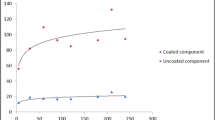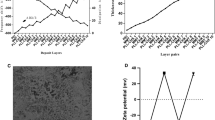Abstract
The aim of this study was the investigation of a copper-filled TiO2 coating, that in vitro showed good antibacterial properties combined with good tissue tolerance in an animal model. To better understand the antibacterial mechanism of the bioactive coating the release of copper (Cu) ions over time was monitored to be able to detect possible threats as well as possible fields of application. 30 New Zealand White rabbits were divided into two groups with 15 animals per group. In group 1 (control group) Ti6Al4 V bolts were implanted into the distal femur, in group 2 the Ti6Al4 V bolts were coated with four TiO2-coatings with integrated Cu2+-ions (4 × Cu–TiO2). Blood tests were performed weekly until the animals were sacrificed 4 weeks postoperative. The maximum peak of Cu and ceruloplasmin concentration could be seen in both groups one week postoperative, whereas the Cu values in group II were significantly higher. The Cu concentration in both groups approximated the initial basic values 4 weeks postoperative. The 4 × Cu–TiO2 coating tested in our rabbit model for total knee arthroplasty is an active coating that releases potentially antibacterial Cu2+ for 4 weeks with a peak 1 week postoperative. The bioactive coating could be a promising approach for a use in the field of implant related infection, orthopaedic revision and tumor surgery in the future.








Similar content being viewed by others
References
Blom AW, Taylor AH, Pattison G, Whitehouse S, Bannister GC. Infection after total hip arthroplasty. The Avon experience. J Bone Joint Surg Br. 2003;85(7):956–9.
Phillips JE, Crane TP, Noy M, Elliott TS, Grimer RJ. The incidence of deep prosthetic infections in a specialist orthopaedic hospital: a 15-year prospective survey. J Bone Joint Surg Br. 2006;88(7):943–8. doi:10.1302/0301-620X.88B7.17150.
Kurtz SM, Lau E, Schmier J, Ong KL, Zhao K, Parvizi J. Infection burden for hip and knee arthroplasty in the United States. J Arthroplasty. 2008;23(7):984–91. doi:10.1016/j.arth.2007.10.017.
Beswick AD, Elvers KT, Smith AJ, Gooberman-Hill R, Lovering A, Blom AW. What is the evidence base to guide surgical treatment of infected hip prostheses? systematic review of longitudinal studies in unselected patients. BMC Med. 2012;10:18. doi:10.1186/1741-7015-10-18.
Zhao L, Chu PK, Zhang Y, Wu Z. Antibacterial coatings on titanium implants. J Biomed Mater Res B. 2009;91(1):470–80. doi:10.1002/jbm.b.31463.
Heidenau F, Mittelmeier W, Detsch R, Haenle M, Stenzel F, Ziegler G, et al. A novel antibacterial titania coating: metal ion toxicity and in vitro surface colonization. J Mater Sci Mater Med. 2005;16(10):883–8. doi:10.1007/s10856-005-4422-3.
Haenle M, Fritsche A, Zietz C, Bader R, Heidenau F, Mittelmeier W, et al. An extended spectrum bactericidal titanium dioxide (TiO2) coating for metallic implants: in vitro effectiveness against MRSA and mechanical properties. J Mater Sci Mater Med. 2011;22(2):381–7. doi:10.1007/s10856-010-4204-4.
Craig MR, Poelstra KA, Sherrell JC, Kwon MS, Belzile EL, Brown TE. A novel total knee arthroplasty infection model in rabbits. J Orthop Res. 2005;23(5):1100–4. doi:10.1016/j.orthres.2005.03.007.
R-Core-Team. R: a language and environment for statistical computing. Vienna: R-Core-Team; 2012.
Sato M, Gitlin JD. Mechanisms of copper incorporation during the biosynthesis of human ceruloplasmin. J Biol Chem. 1991;266(8):5128–34.
Gitlin JD, Schroeder JJ, Lee-Ambrose LM, Cousins RJ. Mechanisms of caeruloplasmin biosynthesis in normal and copper-deficient rats. Biochem J. 1992;282(Pt 3):835–9.
Bielli P, Calabrese L. Structure to function relationships in ceruloplasmin: a ‘moonlighting’ protein. Cell Mol Life Sci. 2002;59(9):1413–27.
Senra Varela A, Lopez Saez JJ, Quintela Senra D. Serum ceruloplasmin as a diagnostic marker of cancer. Cancer Lett. 1997;121(2):139–45.
Stassar MJ, Devitt G, Brosius M, Rinnab L, Prang J, Schradin T, et al. Identification of human renal cell carcinoma associated genes by suppression subtractive hybridization. Br J Cancer. 2001;85(9):1372–82. doi:10.1054/bjoc2001.2074.
Wang KK, Liu N, Radulovich N, Wigle DA, Johnston MR, Shepherd FA, et al. Novel candidate tumor marker genes for lung adenocarcinoma. Oncogene. 2002;21(49):7598–604. doi:10.1038/sj.onc.1205953.
Harris ZL, Gitlin JD. Genetic and molecular basis for copper toxicity. Am J Clin Nutr. 1996;63(5):836S–41S.
Calabrese L, Carbonaro M, Musci G. Chicken ceruloplasmin. Evidence in support of a trinuclear cluster involving type 2 and 3 copper centers. J Biol Chem. 1988;263(14):6480–3.
Danzeisen R, Araya M, Harrison B, Keen C, Solioz M, Thiele D, et al. How reliable and robust are current biomarkers for copper status? Br J Nutr. 2007;98(4):676–83. doi:10.1017/S0007114507798951.
Pizarro F, Olivares M, Uauy R, Contreras P, Rebelo A, Gidi V. Acute gastrointestinal effects of graded levels of copper in drinking water. Environ Health Perspect. 1999;107(2):117–21.
Araya M, Olivares M, Pizarro F, Gonzalez M, Speisky H, Uauy R. Gastrointestinal symptoms and blood indicators of copper load in apparently healthy adults undergoing controlled copper exposure. Am J Clin Nutr. 2003;77(3):646–50.
Arredondo M, Gonzalez M, Olivares M, Pizarro F, Araya M. Ceruloplasmin, an indicator of copper status. Biol Trace Elem Res. 2008;123(1–3):261–9. doi:10.1007/s12011-008-8110-2.
Antoniou J, Zukor DJ, Mwale F, Minarik W, Petit A, Huk OL. Metal ion levels in the blood of patients after hip resurfacing: a comparison between twenty-eight and thirty-six-millimeter-head metal-on-metal prostheses. J Bone Joint Surg Am. 2008;90(Suppl 3):142–8. doi:10.2106/JBJS.H.00442.
Clarke MT, Lee PT, Arora A, Villar RN. Levels of metal ions after small- and large-diameter metal-on-metal hip arthroplasty. J Bone Joint Surg Br. 2003;85(6):913–7.
Vendittoli PA, Mottard S, Roy AG, Dupont C, Lavigne M. Chromium and cobalt ion release following the Durom high carbon content, forged metal-on-metal surface replacement of the hip. J Bone Joint Surg Br. 2007;89(4):441–8. doi:10.1302/0301-620X.89B4.18054.
Skipor AK, Campbell PA, Patterson LM, Anstutz HC, Schmalzried TP, Jacobs JJ. Serum and urine metal levels in patients with metal-on-metal surface arthroplasty. J Mater Sci Mater Med. 2002;13(12):1227–34.
Back DL, Young DA, Shimmin AJ. How do serum cobalt and chromium levels change after metal-on-metal hip resurfacing? Clin Orthop Relat Res. 2005;438:177–81.
Wagner P, Olsson H, Ranstam J, Robertsson O, Zheng MH, Lidgren L. Metal-on-metal joint bearings and hematopoetic malignancy. Acta Orthop. 2012;83(6):553–8. doi:10.3109/17453674.2012.747055.
Little MP. Cancer and non-cancer effects in Japanese atomic bomb survivors. J Radiol Prot. 2009;29(2A):A43–59. doi:10.1088/0952-4746/29/2A/S04.
Araya M, Olivares M, Pizarro F, Gonzalez M, Speisky H, Uauy R. Copper exposure and potential biomarkers of copper metabolism. Biometals. 2003;16(1):199–204.
Turnlund JR, Keyes WR, Peiffer GL, Scott KC. Copper absorption, excretion, and retention by young men consuming low dietary copper determined by using the stable isotope 65Cu. Am J Clin Nutr. 1998;67(6):1219–25.
Turnlund JR, Keyes WR, Anderson HL, Acord LL. Copper absorption and retention in young men at three levels of dietary copper by use of the stable isotope 65Cu. Am J Clin Nutr. 1989;49(5):870–8.
Harvey LJ, Majsak-Newman G, Dainty JR, Lewis DJ, Langford NJ, Crews HM, et al. Adaptive responses in men fed low- and high-copper diets. Br J Nutr. 2003;90(1):161–8.
Araya M, Kelleher SL, Arredondo MA, Sierralta W, Vial MT, Uauy R, et al. Effects of chronic copper exposure during early life in rhesus monkeys. Am J Clin Nutr. 2005;81(5):1065–71.
Keen CL, Graham TW. Trace elements. Clinical biochemistry of domestic animals. 4th ed. New York: Academic Press Inc; 1989.
Singh KK, Gupta MK, Ram M, Singh V, Roy BK. Effect of chronic fenvalerate intoxication on tissue concentration of copper in goats and further exploration of its mechanism. Biol Trace Elem Res. 2010;138(1–3):163–72. doi:10.1007/s12011-010-8629-x.
Acknowledgments
We gratefully acknowledge the “medrasys GmbH, medical technologies”, Pressig, Germany for providing the funding to realize the Project.
Author information
Authors and Affiliations
Corresponding author
Rights and permissions
About this article
Cite this article
Mauerer, A., Lange, B., Welsch, G.H. et al. Release of Cu2+ from a copper-filled TiO2 coating in a rabbit model for total knee arthroplasty. J Mater Sci: Mater Med 25, 813–821 (2014). https://doi.org/10.1007/s10856-013-5116-x
Received:
Accepted:
Published:
Issue Date:
DOI: https://doi.org/10.1007/s10856-013-5116-x




